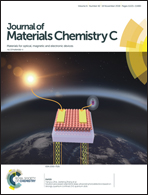Poling effects on the structural, electrical and photoluminescence properties in Sm doped BCST piezoelectric ceramics†
Abstract
Piezoelectrics have shown great potential for controlling the piezoelectro-optical process in multifunctional materials. Electric field poling is an effective way of modulating the structure of rare earth doped piezoelectric materials, thus affecting their piezoelectro–optical interplays. Here, the (Ba0.96Ca0.04)(Ti0.90Sn0.10)O3-0.2%Sm (BCST-Sm) lead-free ceramics exhibit high piezoelectric properties (d33 = 450 pC N−1, kp = 52%) as well as strong reddish-orange photoluminescence emission (PLE). The highest piezoelectric coefficient and PLE quenching of the BCST-Sm ceramics are obtained simultaneously at a poling electric field of 20 kV cm−1, which are related to the phase transition and the changes in lattice symmetry and domain structure. The BCST-Sm ceramics transform from the coexisting R–T phases to a single T phase by applying an electric field, where the long-range ordered large domain structure is induced. The decreased asymmetry and relaxor and the increased domain size contributed to the quenching of photoluminescence (PL) performance, while the instability of the polarization state and domain reorientation benefitted the piezoelectric response. This work demonstrates the inherent piezoelectro–optical interplays in association with various structures stimulated by the electric field and provides a physical mechanism for better understanding and designing multifunctional materials.



 Please wait while we load your content...
Please wait while we load your content...